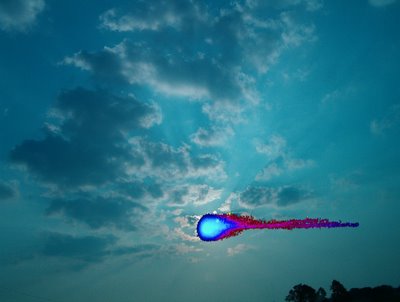
Celestial show under way in night sky
By CHRISTINE S. DIAMOND
The Lufkin Daily News
11-19-05
Seeing a shooting star is considered lucky because its sighting has a lot to do with chance. And lately, chances of seeing a falling star or even a fireball are better than ever for upward-looking East Texans.By CHRISTINE S. DIAMOND
The Lufkin Daily News
11-19-05
About 8:15 p.m. Monday residents of the Monastery of the Infant Jesus saw a "brilliant blue light in the sky, oval in shape with a tail, appearing above the horizon in a general westerly direction."
This late-evening celestial sighting was reported by several in the region including one of Edward Michaels' astronomy students at Stephen F. Austin State University.
"I've had a lot of reports from other people who saw it, the same night," Michaels said. "Extra bright meteors are called fire bolts or fire balls. They are very rare."
A fireball is caused by a piece of dirt the size of pea or pebble, larger than the granular size of a meteor, Michaels said.
Then again, "it could have been a piece of space debris ... a bolt or nut from a space shuttle," Edwards said.
Odds are more likely it was an oversized meteor — given the number of overlapping meteor showers visible in the night sky as Earth's movement along its orbit collides with comets and their debris trails, according to astronomers at NASA Johnson Space Center in Clear Lake.
The tail to this particular sighting is key to its identity as a meteoroid fireball, said Bill Jeffs, public affairs officer for astromaterials at the space center.
The time it was seen also helps determine which meteoroid debris field it belongs to — the Taurids, which are visible as they encounter the earth's atmosphere and catch fire from Oct. 20 to Nov. 30. Leonids' meteors are usually seen after midnight, Jeffs said. Leonids are on display Nov. 15-20, according to NASA.
The bluish color is indicative of the Taurid fireball's temperature, Jeffs said.
"They are red when they enter the Earth's atmosphere," he said, "and become blue as they travel closer to us."
Edwards said the number of brighter Taurid meteors have increased in recent years — their increased brightness is indicative of increased size.
"Its a bigger trail than what you used to see," he said.
At 6:30 p.m. Thursday outside St. Cyprian's School, a couple observed a bright light flaring out of the northern sky, arcing and skittering in mid-air as it broke into several smaller lights, disappearing beyond the horizon.
Meteors are pieces of dirt that collide with the Earth's atmosphere and catch fire. If it survives and passes through the atmosphere it is called a meteorite. Most meteors come from comets.
"Comets are basically dirty snowballs," Edwards said. "As they get closer to the sun they go from solid to gas — that's the tail."
The dust, dirt, and rock thrown from the comet continue to follow the comet's path around the sun.
"It is those things that produce meteor showers ... as our paths collide," he said.
As Earth travels through a comet's debris field, these pieces of tiny rocks or "meteoroids" experience "tremendous friction" as they enter Earth's atmosphere, causing them to burn up 100 miles above the Earth's surface.
Comets themselves are difficult to see as they aren't very bright and their path is surrounded by their own debris.
The best time to view meteor showers is after midnight, Edwards said. He recalled counting more than 1,000 Leonids meteors during a three-hour period a few years ago.
The Geminids meteor shower, named for the constellation it appears to be coming from, will be visible Dec. 7-15, he said.
More . . .
Home

No comments :
Post a Comment
Dear Contributor,
Your comments are greatly appreciated, and coveted; however, blatant mis-use of this site's bandwidth will not be tolerated (e.g., SPAM etc).
Additionally, healthy debate is invited; however, ad hominem and or vitriolic attacks will not be published, nor will "anonymous" criticisms. Please keep your arguments "to the issues" and present them with civility and proper decorum. -FW